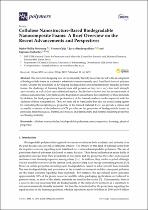 ResearchSpace
ResearchSpace
Cellulose nanostructure-based biodegradable nanocomposite foams: A brief overview on the recent advancements and perspectives
JavaScript is disabled for your browser. Some features of this site may not work without it.
- ResearchSpace
- →
- Research Publications/Outputs
- →
- Journal Articles
- →
- View Item
| dc.contributor.author |
Motloung, Mpho P

|
|
| dc.contributor.author |
Ojijo, Vincent O

|
|
| dc.contributor.author |
Bandyopadhyay, Jayita

|
|
| dc.contributor.author |
Ray, Suprakash S

|
|
| dc.date.accessioned | 2019-10-25T08:35:59Z | |
| dc.date.available | 2019-10-25T08:35:59Z | |
| dc.date.issued | 2019-07 | |
| dc.identifier.citation | Motloung, M.P., Ojijo, V., Bandyopadhyay, J. & Ray, S.S. 2019. Cellulose nanostructure-based biodegradable nanocomposite foams: A brief overview on the recent advancements and perspectives. Polymers, vol 11(8), pp. 1-32 | en_US |
| dc.identifier.issn | 2073-4360 | |
| dc.identifier.uri | https://www.mdpi.com/2073-4360/11/8/1270 | |
| dc.identifier.uri | https://www.ncbi.nlm.nih.gov/pubmed/31370292 | |
| dc.identifier.uri | doi: 10.3390/polym11081270. | |
| dc.identifier.uri | http://hdl.handle.net/10204/11187 | |
| dc.description | © 2019. The Author(s). Published under a Creative Commons Attribution Licence. | en_US |
| dc.description.abstract | The interest in designing new environmentally friendly materials has led to the development of biodegradable foams as a potential substitute to most currently used fossil fuel–derived polymer foams. Despite the possibility of developing biodegradable and environmentally friendly polymer foams, the challenge of foaming biopolymers still persists as they have very low melt strength and viscosity as well as low crystallisation kinetics. Studies have shown that the incorporation of cellulose nanostructure (CN) particles into biopolymers can enhance the foamability of these materials. In addition, the final properties and performance of the foamed products can be improved with the addition of these nanoparticles. They not only aid in foamability but also act as nucleating agents by controlling the morphological properties of the foamed material. Here, we provide a critical and accessible overview of the influence of CN particles on the properties of biodegradable foams; in particular, their rheological, thermal, mechanical, and flammability and thermal insulating properties and biodegradability. | en_US |
| dc.language.iso | en | en_US |
| dc.publisher | MDPI | en_US |
| dc.relation.ispartofseries | Workflow;22722 | |
| dc.subject | Cellulose nanoparticles | en_US |
| dc.subject | Biodegradable polymers | en_US |
| dc.subject | Foaming | en_US |
| dc.subject | Nanocomposites | en_US |
| dc.title | Cellulose nanostructure-based biodegradable nanocomposite foams: A brief overview on the recent advancements and perspectives | en_US |
| dc.type | Article | en_US |
| dc.identifier.apacitation | Motloung, M. P., Ojijo, V. O., Bandyopadhyay, J., & Ray, S. S. (2019). Cellulose nanostructure-based biodegradable nanocomposite foams: A brief overview on the recent advancements and perspectives. http://hdl.handle.net/10204/11187 | en_ZA |
| dc.identifier.chicagocitation | Motloung, Mpho P, Vincent O Ojijo, Jayita Bandyopadhyay, and Suprakash S Ray "Cellulose nanostructure-based biodegradable nanocomposite foams: A brief overview on the recent advancements and perspectives." (2019) http://hdl.handle.net/10204/11187 | en_ZA |
| dc.identifier.vancouvercitation | Motloung MP, Ojijo VO, Bandyopadhyay J, Ray SS. Cellulose nanostructure-based biodegradable nanocomposite foams: A brief overview on the recent advancements and perspectives. 2019; http://hdl.handle.net/10204/11187. | en_ZA |
| dc.identifier.ris | TY - Article AU - Motloung, Mpho P AU - Ojijo, Vincent O AU - Bandyopadhyay, Jayita AU - Ray, Suprakash S AB - The interest in designing new environmentally friendly materials has led to the development of biodegradable foams as a potential substitute to most currently used fossil fuel–derived polymer foams. Despite the possibility of developing biodegradable and environmentally friendly polymer foams, the challenge of foaming biopolymers still persists as they have very low melt strength and viscosity as well as low crystallisation kinetics. Studies have shown that the incorporation of cellulose nanostructure (CN) particles into biopolymers can enhance the foamability of these materials. In addition, the final properties and performance of the foamed products can be improved with the addition of these nanoparticles. They not only aid in foamability but also act as nucleating agents by controlling the morphological properties of the foamed material. Here, we provide a critical and accessible overview of the influence of CN particles on the properties of biodegradable foams; in particular, their rheological, thermal, mechanical, and flammability and thermal insulating properties and biodegradability. DA - 2019-07 DB - ResearchSpace DP - CSIR KW - Cellulose nanoparticles KW - Biodegradable polymers KW - Foaming KW - Nanocomposites LK - https://researchspace.csir.co.za PY - 2019 SM - 2073-4360 T1 - Cellulose nanostructure-based biodegradable nanocomposite foams: A brief overview on the recent advancements and perspectives TI - Cellulose nanostructure-based biodegradable nanocomposite foams: A brief overview on the recent advancements and perspectives UR - http://hdl.handle.net/10204/11187 ER - | en_ZA |





